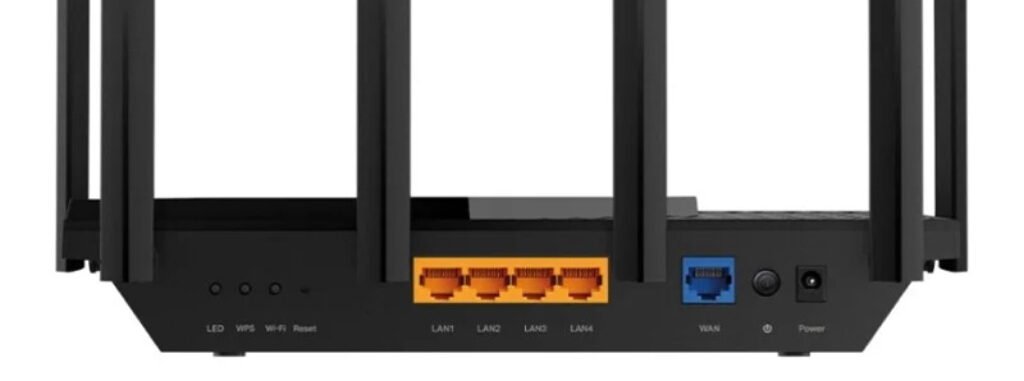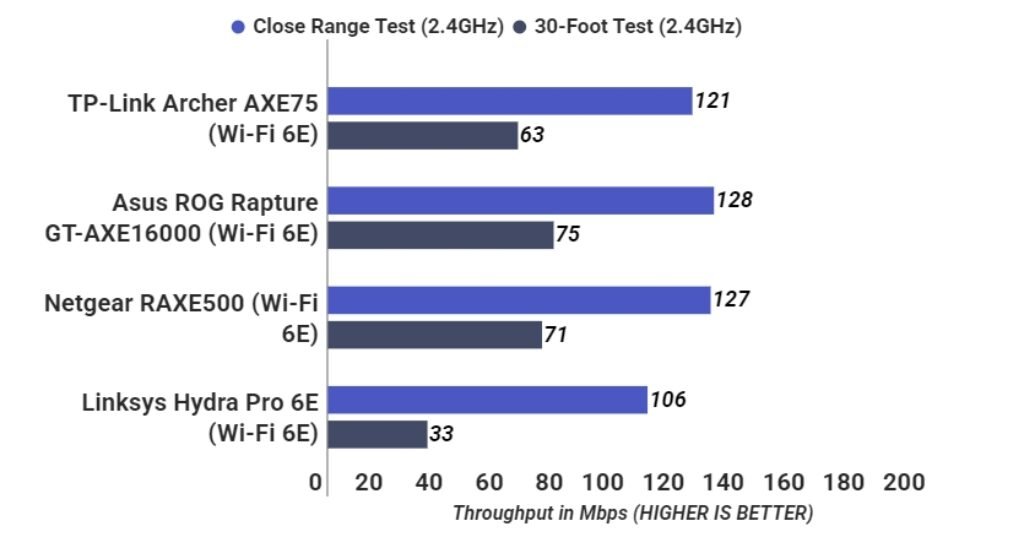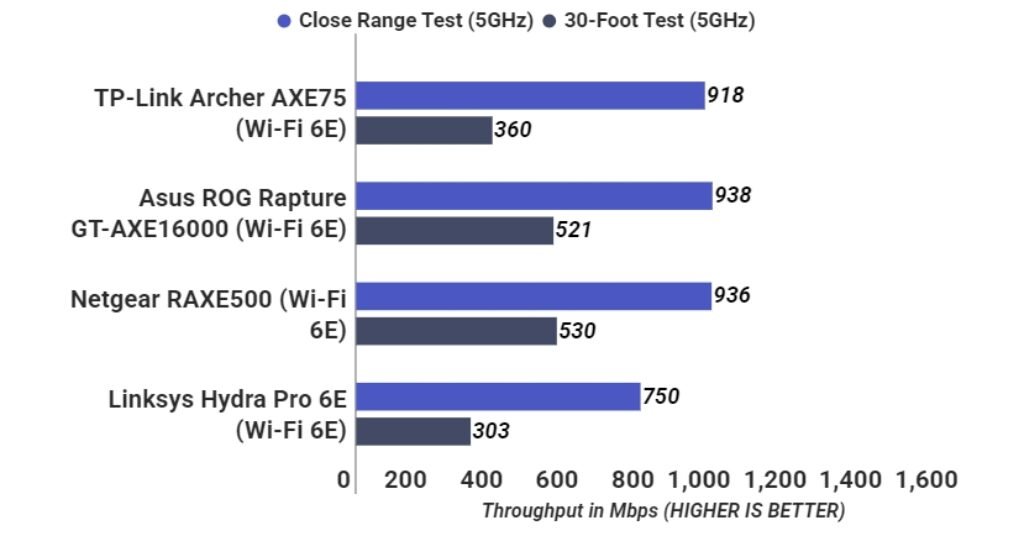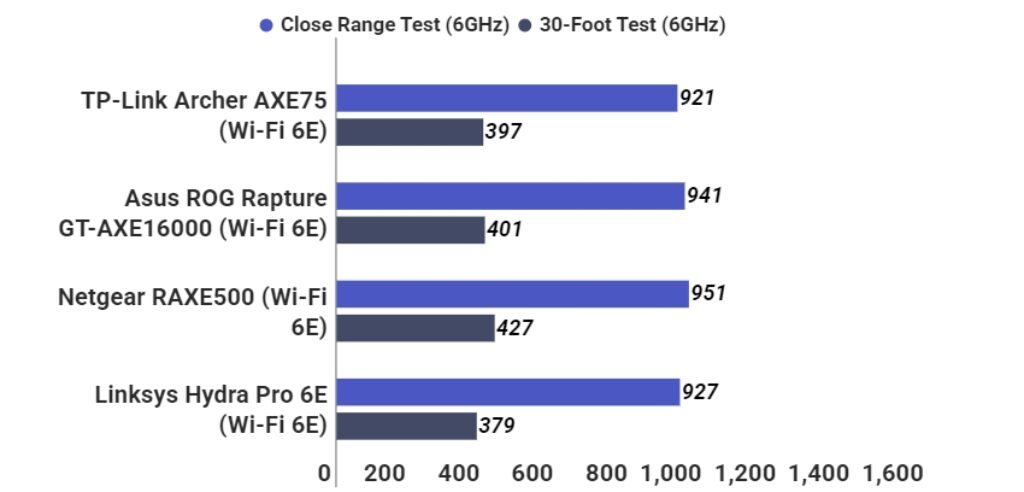The TP-Link Archer AXE75 router is a relatively inexpensive tri-band Wi-Fi 6E router and an entry-level model that will give you access to the less crowded 6GHz radio band. It provides a reliable performance and is perfect for individuals with tight budget in spite of their longing for a future-proofed network.

TP-Link Archer AXE75 Router Pros and Cons
TP-Link Archer AXE75 Router Design
The TP-Link Archer AXE75 router is packaged inside a nice and strong box with good looks. The minute I opened the box, my eyes went to the router’s sleek, contemporary design. It is a smooth, black glossy surface with a gentle texture underneath which feels pretty good quality. Not so much the TP-Link Archer AXE75, which is just 10.7 inches × 5.8 inches × 1.9 inches (not including its six foldable antennas). Its form factor is similar to a small cutoff tray. The top of the Archer AXE75 router is nearly all ventilation ports—the pattern of them reminiscent of a tile floor mosaic. The sole exception is a high-gloss ridge that’s about three inches wide and runs diagonally across nearly a third of the device. It comes with a USB 3.0 port, but instead of being in the back like all other ports and key hardware, it resides on the side.

This unit has a heap of other good functions along with the USB port. On its backside, it has an LED power button (nice for those, like me, who hate unnecessary lights on gadgets), a WPS button, and a “WiFi on/off” switch button. On the back of the device, you’ll also find four Ethernet ports, a WAN port and a power button.
TP-Link Archer AXE75 Router Feature
- Tri-Band WiFi 6E Router – 5.4Gbps WiFi for faster browsing, streaming, gaming, and downloading and all at the same time (6 GHz: 2.4Gbps, 5 GHz: 2.4Gbps, 2.4al: 574Mbps)
- Wi-Fi 6E Unleashed: The latest 6 GHz spectrum provides more available channels and less interference for better gaming and video conferencing experiences; Extra
- Extend WiFi Coverage—Extend the range of your WiFi with the included satellite (Requires connection to your router); Guest WiFi Network—Provide internet access to friends and family without sharing your personal network password.
- Improved Performance, Better Processing – Packed with 1. 7 GHz Quad-Core CPU / Xstream Processor and 512 MB High Speed Memory
- OneMesh Supported – Utilize a OneMesh device so you’re always connected to the strongest Wi-Fi, even as you carry it from room to room.
- VPN Server and Client: Supports both VPN Server and VPN Client (OpenVPN / PPTP / L2TP)
- TP-Link HomeShield – TP-Link’s premium security services provides, real-time security that guards against cyber threats, with robust parental controls and privacy protection. Free features: 1. CoRE Security Profile for AuthorizationZBT 2. Basic Parental Controls 3. Quality of Service 4. Basic Weekly/Monthly Reports. For further details please see TP-Link website.
- Compatible with all internet service providers including AT&T, Verizon, Xfinity, Spectrum, RCN, Cox, CenturyLink, and more.
TP-Link Archer AXE75 Router Specifications
| Brand | TP-Link |
| Model Name | TP-Link AXE5400 Tri-Band WiFi 6E Router (Archer AXE75) |
| Dimensions | 10.7″ × 5.8″ × 1.9″ |
| Processor | 1.7 GHz quad-core Processor |
| Operating Frequency | 2.4 GHz / 5 GHz / 6 GHz |
| Data Rates | 2.4 GHz: 574 Mbps (802.11ax); 5 GHz: 2402 Mbps (802.11ax); 6 GHz: 2402 Mbps (802.11ax) |
| Special Feature | WPS, Internet Security, LED Indicator, Alexa Compatible, Parental Control, QoS, Beamforming |
| Frequency Band Class | Tri-Band |
| Wireless Communication Standard | 802.11ax |
| Compatible Devices | Personal Computer, Smartphone, Gaming Console, Tablet, Smart Television, Printer, Security Camera, Smart ThermostatPersonal Computer, Smartphone, Gaming Console, Tablet, Smart Television, Printer, Security Camera, Smart Thermostat |
| Recommended Uses For Product | Streaming, Gaming, Home |
| Included Components | Power Adapter, RJ45 Ethernet Cable, Quick Installation Guide, Wi-Fi Router Archer AXE75 |
| Connectivity Technology | Wi-Fi,USB,WAN,LAN |
TP-Link Archer AXE75 Router Performance
The $200 TP-Link Archer AXE75 is less expensive, and performance-wise, it was steady but not as excellent in lab tests here. During my trials, the 2.4GHz band delivered 121Mbps at close range, performing better than the Linksys Hydra Pro 6E (106Mbps) but just barely lagging both the ASUS ROG Rapture GT-AXE16000 (128Mbps) and the Netgear RAXE500 (127Mbps). In a 30-foot (about 9 meters) test, it was more of the same: The AXE75 turned in a speed of 63 Mbps, faster than the showings from the Linksys Hydra Pro 6E (33 Mbps) but a little bit behind those of the ASUS ROG Rapture GT-AXE16000 (75 Mbps) or the Netgear RAXE500 (71 Mbps).

In our 5G close-proximity test, Archer AXE75 router hit a speed of 918 Mbps. That’s faster than the Linksys Hydra Pro 6E (750 Mbps), but a touch behind the ASUS ROG Rapture GT-AXE16000 (938 Mbps) and the Netgear RAXE500 (936 Mbps). On our 30-foot (9-metre) test, the AXE75 provided a network speed of 360 Mbps, faster than the Linksys Hydra Pro 6E (303 Mbps), but slower than the ASUS ROG Rapture GT-AXE16000 (521 Mbps) and Netgear RAXE500 (530 Mbps).

The TP-Link Archer AXE75’s 6GHz speeds are almost the same as its 5GHz speeds. In our close-range test, it delivered a network speed of 921 Mbps, slower than the Linksys Hydra Pro 6E’s 927 Mbps. At 30 feet (9 meters), the AXE75 earned a network speed of 397 Mbps, faster than that of the Linksys Hydra Pro 6E (379 Mbps) but slower than the one assigned to the ASUS ROG Rapture GT-AXE16000 (401 Mbps) and the Netgear RAXE500 (427 Mbps).

Archer AXE75 turned in a write speed of 44 MBps on our file transfer tests, slightly slower than the Asus ROG Rapture GT-AXE16000 (48 MBps) and 11 MBps behind the Linksus Hydra Pro 6E (55 MBps). The Netgear RAXE500 beat them all, with a write speed of 70 MBps. The Archer AXE75 is a smidge faster than the ASUS ROG Rapture GT-AXE16000 (45 MBps) in read tests, but it can’t keep up with the Linksys Hydra Pro 6E (57 MBps) or the Netgear RAXE500 (68 MBps).




 Amazon.com
Amazon.com 



